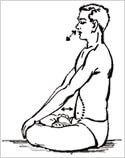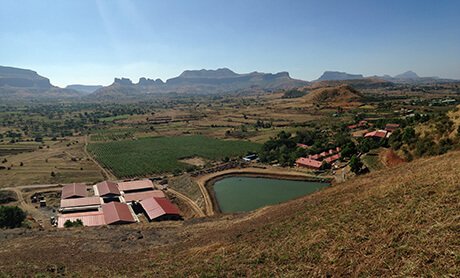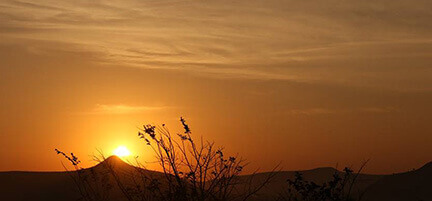
Pranayama from Hatha Yoga Pradipika - as mentioned in Hatha Yoga
The Following Types of Pranayama should only be practiced under the direct guidance of Expert Guru. Please DO NOT Practice by reading the following article, it may be harmful to your health.
Prana is vital energy, and ayama is control and extension of the Pranic energy. Swami Swatmarama in Hatha Yoga Pradipika talks about Pranayama as the way to awaken the kundalini, regular practice of Pranayama can lead to spiritual awakening and self realization. He describes various types of Pranayama, which has different effects on the body, mind and spirit.
Considering the physiology of Pranayama, Swami Niranjananda of Bihar School of Yoga has classified Pranayama as hyperventilation and hypoventilation. Mainly Kapalbhati, & Bhastrika Pranayama are considered as Hyperventilation type of Pranayama, this type of Pranayama revitalizes body. Bharamari, Shitali, Sitkari, Ujjayi etc are considered as hypoventilation. Though kapalbhati is described as cleansing technique in Hatha Yoga, it reduces the carbon dioxide (CO2) percentage in blood so it can be classified as hyperventilation Pranayama.
Kumbhaka (Retention of air) along with Bandhas (energy locks) is very important in Pranayama, it has long lasting effects on nervous system, brain and other parts of the body. So guidance of Guru is essential for practicing Pranayama. The practice of Kumbhaka increases the CO2 in the blood, which stresses the nervous system, and continuous practice results in nervous system becoming tolerant. Some of the Yogis have displayed unique capacity to survive without O2, with regular practice of Pranayama.
Balancing the Ida and Pingala, the mental force and vital force is one of the main objectives of Pranayama. Left nostril (Ida) and right nostril (Pingala) if balanced can awaken Sushumna (the psychic nadi or channel carrying kundalini) nadi. Swami Swatmarama recommends Nadi Shodhan Pranayama, (alternate nostril breathing with Kumbhaka and Bandhas) for purifying Ida Nadi and Pingala Nadi.
urya is sun, in the body pingala nadi represents energy of Sun or vital energy, Surya Bhedan Pranayama increases vital energy in the body, and it is revitalizing Pranayama. It is practiced by inhaling with right nostril, then performing kumbhaka with bandhas (Jalandhar Bandha or Chin Lock, Moola Bandha or Anus lock and Uddiyan Bandha or Abdominal Lock) and exhaling through left nostril. This Pranayama stimulates the sympathetic nervous system and left part of the brain. It eliminates wind or gas related trouble (Vata Dosha as per Ayurveda) and balances Mucus (Kapha as per Ayurveda) and Bile / acidity (Pitta Dosha as per Ayurveda).
This literally means one has to operate lungs like the bellow, fast inhalation and fast exhalation, followed by inhaling through right nostril and performing kumbhaka with bandhas and exhaling through left nostril, this is is Bhastrika Pranayama. This is vitalizing type of Pranayama. This rhythmic inhalation and exhalation stimulates the circulation of cerebral fluid, creating compression and decompression in the brain. Rhythmic diaphragm movements stimulate heart & lung muscles improving blood circulation. Accelerated blood circulation and rate of gas exchange in each cell produces heat and washes out gases.
In this Pranayama one has to make sound like humming bee while exhalation and inhalation as well. This Pranayama increases psychic sensitivity and awareness of subtle sound vibrations, this proves to be useful for Nada Meditation. This is useful in removing stress and mental problems like anxiety, depression, anger etc.
This is also called psychic breath. This type of Pranayama is done with inhalation via nostrils then performing Bandhas and exhaling through left. During inhalation and exhalation a typical sound (Ujjayi Sound) should be created by compressing epiglottis in the throat. Ujjayi sound can be combined with So-Ham or Guru Mantra for better awareness of Mantra. Ujjayi Pranayama has therapy applications, especially useful in insomnia, tensions, and heart diseases. This should not be practiced in Low blood pressure, as the practice of this Pranayama puts pressure on carotid sinus which further reduces blood pressure.
This is done by opening lips, keeping the upper and lower teeth touching each other, then inhaling through mouth with hissing sound, then performing kumbhaka with bandhas and then exhaling with nostrils. The air passing via tongue, cools the blood, lowering the temperature of the blood. This type of Pranayama removes excess heat in the body. Also the diseases like acidity, hypertension etc. This Pranayama harmonizes the secretions of reproductive organs and all the endocrine system. Also it improves digestion, lowers High Blood pressure, purifies the blood.
Tongue is rolled and inhalation is done via mouth followed by Kumbhaka with Bandhas and then exhalation with nostrils. The effects of the Shitali are same as Sitkari Pranayama.
This type of Pranayama induces a state of "conscious unconsciousness" (in the words of Swami Satyananda of Bihar School of Yoga). One should inhale through both the nostrils, the kumbhaka with Bandhas, but while exhaling the Jalandhar Bandha (Chin Lock) is kept intact and then exhalation is done with the Jalandhar bandha (Chin lock). Excess pressure is exerted on carotid sinus during exhalation with Jalandhar bandha, which further reduces blood pressure and one can experience a state of unconsciousness with practice.
This Pranayama involves high risks so should not be practiced with out the Direct Guidance of Guru.
After inhalation the air is filled in to stomach and kept inside for some time. Swami Satyananda mentions that one can inhale the air via mouth while practicing this. Text of Hatha Yoga Pradipika mentions that one can float easily on water with this Pranayama. This Pranayama helps remove most of the ailments of stomach or digestive system.
Phone - +91-9822770727
E-mail - yoga@yogapoint.com or yogapoint108@gmail.com

Yoga Vidya Dham, Kaivalya Nagari,
College Road, Nashik - 422005.
Maharashtra, India.
Phone - +91-9822770727 (for courses in ENGLISH)
+91-253-2318090 (For courses, in HINDI or MARATHI)
(Please call during 9.00 AM to 5 PM Indian Time)
E-mail - yoga@yogapoint.co or yogapoint108@gmail.com
Village Talwade, Trimbak, Nasik
Maharashtra,India.
Phone - +91-9822770727
E-mail - yoga@yogapoint.com or yogapoint108@gmail.com
